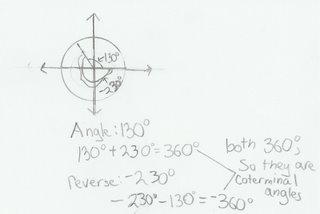Chapter 2 Section 2
Chapter 2, Section 2
It is going to be very hard to top the posting by Nick, but I will try. I would like to present chapter 2, section 2: Measurement of Rotation. This section is very much about what the title says.
Key definitions/terms/ideas to note:
Periodic Functions: A function that repeats its values at regular functions
Coterminal Angles: Two angles in standard position are coterminal if and only if their degree measures differ by 360 degrees
Example:

Reference Angle: The acute angle nearest to the x-axis
Example:

Basic Information:
- Instead of using an x and y axis, use a u and v axis
- When you have a positive angle measure, move counterclockwise. When you have a negative angle measure, move clockwise.

Solving when given a large angle:
- Divide the large angle, and divide it by 360 (representing a full revolution)
- Multiply the decimal place of the answer by 360 (the whole numbers are the entire revolutions, and the decimal is the part of the revolution, so you multiply it by 360 to see what the actual degree measure is.
Example:
Given: 4221 degrees 4221/360=11.725, 𝑡𝑎𝑘𝑒 .725 𝑎𝑛𝑑 𝑚𝑢𝑙𝑡𝑖𝑝𝑙𝑦 𝑖𝑡 𝑏𝑦 360: 0.725360=261
Therefore, there is a counter clockwise rotation of 261 degrees. The reference angle is 81 degrees.
Question: Find the reference angle when given a rotation of 4302 degrees.
How to solve: divide 4302 by 360. Then from the 11.95 you get as a result, take the decimal and multiply it by 360. You should get a rotation of 342 degrees. From there, you know it is in the fourth quadrant, so take 360 minus 342, and you should get the reference angle.
The angle is 18 degrees.
__________________________________________________________
A reminder to katiecorr to post the next set of notes
__________________________________________________________
Here is a convenient website that calculates reference angle measures when you have a very large angle.
I figure people might as well know about one of Flintridge Prep’s most successful sports, so here is the Flintridge Prep Cross Country Wikipedia.
feel free to ask any questions




